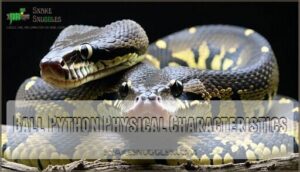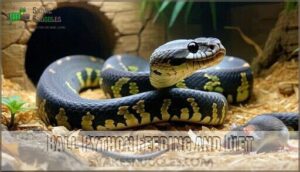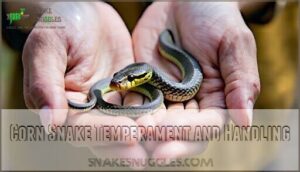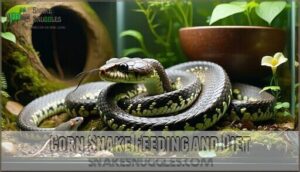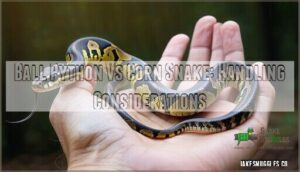This site is supported by our readers. We may earn a commission, at no cost to you, if you purchase through links.
 When comparing corn snake vs ball python, you’ll find corn snakes are typically better for beginners.
When comparing corn snake vs ball python, you’ll find corn snakes are typically better for beginners.
They’re less finicky about feeding, tolerate handling mistakes better, and need simpler temperature setups.
Ball pythons offer a more substantial feel during handling but require stricter humidity control and can go on frustrating feeding strikes.
Corn snakes stay smaller (3-5 feet) while ball pythons reach 4-6 feet and live longer.
Both make excellent pets, but corn snakes forgive rookie mistakes more readily.
Your choice depends on whether you want easier care or don’t mind extra attention to environmental details, considering the substantial feel of ball pythons.
Table Of Contents
- Key Takeaways
- Choosing Between Corn Snakes and Ball Pythons
- What Are Ball Pythons?
- What Are Corn Snakes?
- Ball Python Vs Corn Snake: Handling Considerations
- Housing and Care for Corn Snakes and Ball Pythons
- Feeding Corn Snakes and Ball Pythons
- Ball Python Vs Corn Snake: Cost and Availability
- Health Considerations for Corn Snakes and Ball Pythons
- Choosing The Right Snake for Beginners
- Frequently Asked Questions (FAQs)
- What is the friendliest snake to have as a pet?
- What is the difference between a ball python and a corn snake?
- Are ball pythons a good pet snake?
- Do pythons live longer than corn snakes?
- Will a corn snake bite a ball python?
- Are ball pythons or corn snakes nicer?
- Are corn snakes for beginners?
- Can corn snakes be friendly?
- Do corn snakes like to be touched?
- Do corn snakes and ball pythons have fangs?
- Conclusion
Key Takeaways
- You’ll find corn snakes more forgiving as a beginner – they tolerate handling mistakes better, rarely refuse meals, and thrive in simpler temperature setups without strict humidity requirements.
- Ball pythons require more precise care – they need 50-60% humidity, can go on frustrating feeding strikes for months, and demand stricter environmental controls that beginners often struggle with.
- Corn snakes stay smaller and more active – reaching 4-6 feet with slender builds, they’re easier to handle and more curious, while ball pythons grow stockier at 3-5 feet with calmer temperaments.
- Ball pythons live significantly longer – averaging 20-30 years compared to corn snakes’ 15-20 years, making them a true generational commitment that outlasts most other pet choices.
Choosing Between Corn Snakes and Ball Pythons
You’re choosing between two of the most popular pet snakes, each with distinct characteristics that suit different owner preferences.
Both corn snakes and ball pythons offer excellent beginner-friendly options, but their differences in care requirements, temperament, and handling make one species more suitable for your specific situation than the other.
Lifespan Comparison of Corn Snakes and Ball Pythons
When considering snake longevity, ball pythons substantially outlive corn snakes in captivity.
Ball pythons boast an average lifespan of 20-30 years, with some exceptional individuals reaching over 40 years.
The record holder lived an impressive 47.6 years!
Corn snakes, while still long-lived companions, typically reach 15-20 years with proper care.
Several factors affecting snake lifespan include genetics, diet quality, veterinary care, and husbandry conditions.
Captivity impact dramatically extends life expectancy for both species compared to their wild counterparts, where ball pythons average 10-15 years and corn snakes only 6-8 years.
Key Lifespan Facts:
- Ball python maximum age exceeds 47 years in captivity
- Corn snake lifespan averages 15-20 years with ideal care
- Generational differences show ball pythons living twice as long
- Life expectancy increases dramatically in controlled environments
- Snake longevity depends heavily on consistent husbandry and healthcare
This substantial difference makes ball pythons a true generational pet commitment.
Size Differences Between Corn Snakes and Ball Pythons
How do these two popular pet snakes compare in size? Understanding their growth differences helps you plan the right setup from day one.
| Aspect | Ball Python | Corn Snake |
|---|---|---|
| Adult Length | 3-5 feet | 4-6 feet |
| Body Mass | Stocky, muscular build | Slim, lightweight frame |
| Growth Rate | Slower, steady development | Faster growth to adult size |
| Enclosure Size | 4x2x2 feet minimum | 30-40 gallon tank sufficient |
| Sexual Dimorphism | Females slightly larger | Males and females similar |
Ball python size features a heavier, more compact build despite being shorter. Corn snake size appears longer but remains slender throughout life, making handling easier for beginners.
Ball pythons, with their docile nature, are known to curl into a ball when stressed.
Temperament and Handling of Both Species
Both species offer excellent docile temperament for beginners, but handle differently.
Corn snake handling reveals curious, active personalities with minimal defensive behaviors.
Ball python handling feels like holding a gentle weight—they’re shyer but extremely calm.
Regular handling frequency improves socialization needs for both.
Beginner snakes rarely bite, though corn snakes explore more during snake handling sessions.
Cost and Availability of Corn Snakes and Ball Pythons
Beyond temperament considerations, your budget matters when choosing between these species. Snake cost varies substantially between corn snakes and ball pythons.
Here’s what affects your wallet:
- Initial setup runs $200-400 for proper enclosures, heating, and equipment
- Snake price ranges from $40-100 for corn snakes, $50-250+ for ball pythons
- Corn snake morphs and ball python morphs dramatically impact costs on morph market
- Long-term expenses include food ($20-40 yearly) and occasional veterinary costs
- Adoption options through rescues offer budget-friendly alternatives
Both species show excellent snake availability through breeders and pet stores nationwide.
What Are Ball Pythons?
Ball pythons are stocky, muscular snakes from Sub-Saharan Africa that typically grow 3-5 feet long and earn their name from their defensive habit of curling into a tight ball when threatened.
You’ll find these docile reptiles come in stunning color morphs and prefer warm, humid environments that mimic their tropical homeland.
Ball Python Physical Characteristics
Ball pythons showcase remarkable size variations and color morphs that make each specimen unique.
Their muscular build creates a distinctive stocky appearance that’s both impressive and manageable for handlers.
- Sexual dimorphism appears clearly – females reach up to 6 feet while males stay around 4 feet
- Pattern complexity features intricate blotched designs across their bulky bodies
- Color morphs range from earth tones to vibrant designer variations
- Snake build emphasizes width over length, creating that characteristic girthy profile
- Weight typically ranges 3-5 pounds with regular shedding every 4-6 weeks
Ball Python Temperament and Handling
After understanding their physical traits, you’ll want to know how ball pythons behave as pets.
These snakes showcase a docile nature that makes them perfect for beginners seeking predictable companions.
Their defensive behaviors typically involve curling into tight balls rather than aggressive striking, earning their common name.
Regular handling frequency of 2-3 times weekly builds their snake handling tolerance effectively.
Proper socialization methods include gentle, confident movements that respect their snake temperament.
When stressed, they’ll display clear snake behavior signals you can learn to recognize and address appropriately.
| Handling Aspect | Ball Python Response |
|---|---|
| Stress Response | Curls into defensive ball |
| Bite Likelihood | Extremely rare when calm |
| Handle Duration | 10-15 minutes per session |
| Beginner Friendliness | Highly suitable for novices |
Ball Python Feeding and Diet
You’ll find that ball pythons can be surprisingly finicky in regards to snake feeding.
These reptiles primarily eat snake rodents like mice and rats, with prey size matching their body width.
Feeding refusals are common, especially during winter months or breeding season.
Many owners prefer frozen prey over live feeding for safety reasons.
Dietary supplements aren’t typically necessary with whole prey items.
Ball Python Health Issues and Care Requirements
Maintaining proper care substantially reduces your ball python’s health risks.
These pythons face several common issues that you’ll want to monitor closely.
- Respiratory Infections develop when humidity drops below 50% or temperatures fluctuate wildly
- Shedding Problems occur frequently, with 25% experiencing incomplete sheds annually
- Picky Eating habits can last months, causing unnecessary owner stress
- Obesity Prevention requires monitoring prey size and feeding frequency carefully
- Enclosure Maintenance every two weeks prevents snake mites and scale rot effectively
Regular snake health monitoring catches snake stomatitis and other snake respiratory infections early.
What Are Corn Snakes?
If you’re considering a corn snake as your first pet reptile, you’ll find these North American natives are among the most beginner-friendly serpents available.
Unlike their ball python cousins, corn snakes are reliable feeders with straightforward care requirements that won’t leave you guessing about their needs.
Corn Snake Physical Characteristics
Featuring slender builds and vibrant color morphs, corn snakes showcase nature’s artistry through distinctive scale patterns and markings variation.
Their adult size reaches 4-6 feet, displaying physical appearance that’s lighter than Python regius.
| Characteristic | Description |
|---|---|
| Body Shape | Slim, elongated build |
| Adult Size | 4-6 feet length |
| Color Morphs | Orange, red, yellow variations |
| Scale Patterns | Corn kernel belly markings |
Corn Snake Temperament and Handling
Corn snakes showcase their docile nature through calm, curious behavior that makes handling straightforward for beginners.
Their temperament shifts from defensive juvenile behavior including musking defense to relaxed adults displaying remarkable interactive qualities. Regular handling frequency builds trust and reduces stress responses.
Snake handling best practices include:
- Support their body weight completely during sessions
- Move slowly to avoid triggering defensive responses
- Watch for clear eyes indicating readiness for interaction
- Schedule sessions between meals for ideal snake handling precautions
Corn Snake Feeding and Diet
You’ll want to establish a regular feeding schedule for your corn snake.
Hatchlings need meals weekly, while adults eat every 14-21 days based on their feeding frequency requirements.
Prey size should match 1.5 times your snake’s widest point – typically snake mouse or snake rat.
Your snake diet works well with frozen vs live options, though corn snakes rarely show refusal causes.
Occasional supplementation needs support ideal nutrition for your snake feeding schedule.
Corn Snake Health Issues and Care Requirements
While corn snakes are hardy pets, you’ll need to watch for respiratory infections, shedding problems, and scale rot.
Poor enclosure hygiene often triggers these snake health issues, so maintaining proper humidity and cleanliness prevents most problems.
Key health considerations include:
- Respiratory infections from improper humidity (maintain 40-60%)
- Parasites and mites requiring quarantine protocols
- Mouth rot and prolapses from substrate contamination
Ball Python Vs Corn Snake: Handling Considerations
When you’re ready to handle your snake, understanding the differences between ball pythons and corn snakes becomes essential for safe interactions.
Ball pythons need more support due to their stocky build, while corn snakes are lighter and easier to manage with one hand, which is a key factor in determining how to handle them safely, emphasizing the need for safe interactions.
Handling Techniques for Ball Pythons
Ball python handling requires patience and gentle Support Techniques since these snakes display unique Defensive Postures when stressed.
You’ll notice your python curling into its signature ball shape—don’t rush this moment. Juvenile Handling demands extra care, as younger pythons show more defensive behaviors than adults.
Temperament Factors vary between individuals, so observe your snake’s mood before interaction. Maintain proper snake handling hygiene with thorough snake handwashing before and after sessions.
Handling Frequency should remain consistent at 2-3 times weekly for ideal snake pet interaction and socialization.
| Handling Stage | Ball Python Response | Your Action |
|---|---|---|
| Initial approach | Defensive curling | Wait patiently |
| Gentle contact | Gradual relaxation | Slow, steady movements |
| Full handling | Calm exploration | Support body weight |
Handling Techniques for Corn Snakes
While ball pythons curl defensively, corn snakes handle differently.
Safe Approach starts with Reading Cues – watch for tail rattling or musking behaviors that signal stress.
Support Methods require gentle, confident movements during Juvenile Handling.
Reducing Stress means limiting snake handling frequency to twice weekly and maintaining proper snake reptile handling hygiene through snake handwashing before snake human touch interactions.
| Handling Aspect | Technique |
|---|---|
| Pre-handling | Wait 48 hours after feeding |
| Support | Cradle body with both hands |
| Duration | 10-15 minutes maximum |
Support and Restraint Requirements for Both Species
Proper technique makes all the difference when supporting these reptiles during handling sessions.
Corn snakes need gentle, distributed body support along their length, while ball pythons require firm, secure restraint due to their muscular build.
You’ll want to control their tail movement and watch for signs of stress like rapid breathing or defensive posturing.
Safe restraint involves supporting at least one-third of their body weight, with handling frequency kept moderate to prevent anxiety.
| Aspect | Corn Snake | Ball Python |
|---|---|---|
| Body Support | Light, distributed along length | Firm, secure grip needed |
| Tail Control | Guide gently, allow movement | Support weight, prevent coiling |
| Handling Frequency | 2-3 times weekly maximum | Less frequent, shorter sessions |
Biting and Stress Behaviors in Both Species
Understanding snake defensive behaviors helps you prevent bites and handle stress effectively. While corn snakes rarely bite, recognizing temperament differences between species guarantees safer interactions.
Ball pythons curl defensively when threatened, whereas corn snakes may exhibit musking behavior or hiss aggressively. As detailed in an exhaustive guide, ball pythons are calmer and more docile than corn snakes.
| Stress Signal | Ball Python | Corn Snake |
|---|---|---|
| Primary Defense | Curls into tight ball | Hisses, flattens head |
| Secondary Behavior | Remains motionless | May release musk scent |
| Bite Likelihood | Very rare when calm | Slightly more defensive |
Proper handling stress management involves recognizing these snake stress indicators early, guaranteeing your snake defensive behavior doesn’t escalate to actual strikes, which is crucial for maintaining a safe and healthy environment for both you and your pet snake.
Housing and Care for Corn Snakes and Ball Pythons
Setting up proper housing for your snake is essential for their health and happiness, whether you choose a ball python or corn snake.
Each species has specific requirements for enclosure size, temperature, humidity, and environmental enrichment that you’ll need to meet for successful long-term care.
This includes considering the unique needs of your pet to ensure complete concepts of care are met.
Enclosure Size and Requirements for Ball Pythons
Setting up your ball python’s home requires careful planning to guarantee they thrive. Adult ball pythons need a Minimum Enclosure Size of at least 4x2x2 feet (40+ gallons), providing adequate space for movement and Vertical Space Needs for climbing.
Your snake enclosure must include secure Hides and Security spots on both warm and cool sides. The Heating Setup should maintain 88-92°F basking areas with proper Humidity Control at 55-65%.
Consider these essentials for your snake terrarium:
- Watching your snake explore their perfectly sized snake habitat brings pure joy
- Creating the ideal snake terrarium size gives you confidence as a responsible owner
- Meeting proper snake enclosure requirements guarantees your pet’s long, healthy life
Enclosure Size
Ventilation
Substrate Coconut fiber is great!
Enclosure Size and Requirements for Corn Snakes
Corn snakes need spacious snake enclosures with enclosure dimensions of at least 40 gallons for adults.
These active climbers require vertical snake terrarium space with branches and secure lids for cage security.
You’ll want multiple hide placement spots and easy water access.
Their climbing needs make taller snake habitat setups better than wide ones for proper snake terrarium size requirements.
Temperature and Humidity Requirements for Both Species
Now that you’ve chosen the right enclosure size, getting the environmental conditions right makes all the difference for your snake’s health and comfort.
Ball pythons and corn snakes have distinctly different temperature requirements that reflect their natural habitats. Your ball python needs a basking temperature of 88-92°F with a cool side around 78-80°F, while corn snakes prefer slightly cooler conditions with basking spots at 85-88°F and cool areas at 75°F.
This temperature gradient lets both species thermoregulate naturally.
Humidity needs create the biggest contrast between these species. Ball pythons require 50-60% humidity levels, spiking to 70-80% during shedding periods to prevent retained shed issues. Corn snakes thrive at lower 40-60% humidity, making them easier to maintain in most home environments.
Poor environmental conditions quickly lead to respiratory problems in both species, especially when temperatures drop below their minimums or humidity levels swing wildly.
A quality thermostat is essential for maintaining the correct temperatures.
Seasonal adjustments may be necessary as your home’s conditions change throughout the year, requiring careful monitoring with digital thermostats and hygrometers.
Substrate and Decor Options for Both Species
Right substrate matters as much as temperature and humidity.
For corn snakes, choose aspen shavings – they’re safe, absorbent, and support burrowing needs.
Ball pythons need coconut fiber for better humidity retention.
Add branches for climbing enrichment and multiple hides variety at different temperatures.
Both species require substrate safety – avoid cedar or pine shavings that can cause respiratory issues.
Many owners buy safe bedding options specifically designed for snakes.
Feeding Corn Snakes and Ball Pythons
Understanding what to feed your snake and how often they eat can make the difference between a thriving pet and a stressed one.
Both corn snakes and ball pythons have specific dietary needs, but their feeding behaviors couldn’t be more different.
Diet and Prey Requirements for Ball Pythons
Ball pythons thrive on appropriately sized frozen prey like mice and rats.
Prey size should match the snake’s widest point, preventing digestion issues.
These snakes often experience feeding refusals, especially during cooler months or breeding season.
While live feeding is possible, snake frozen and snake thawed options are safer, eliminating bite risks during snake feeding sessions.
Diet and Prey Requirements for Corn Snakes
Understanding corn snake dietary needs helps you provide proper nutrition for your pet.
These North American natives thrive on appropriately sized rodents, with frozen-thawed prey being the safer choice over live options.
- Prey size: Should equal 1-1.5 times your snake’s widest body section
- Frozen vs live: Frozen snake prey eliminates injury risks and parasites
- Dietary variety: Mice and rats provide complete nutrition without supplementation needs
- Snake digestion: Whole prey delivers balanced nutrients for ideal snake feeding
Feeding Frequencies for Both Species
The feeding frequency equation changes dramatically as your snake matures.
Feeding schedules start aggressive with hatchlings—corn snakes need prey size meals every 5-7 days, ball pythons every 5 days.
Adults shift to relaxed schedules: corn snakes every 14-21 days, ball pythons stretching 4-6 weeks.
Growth stages directly impact snake feeding frequency and snake digestion time, requiring careful schedule adjustments.
Feeding Techniques and Safety Precautions
Safe handling during feeding prevents injuries to both you and your snake. Here’s how to feed your corn snake or ball python securely:
Proper feeding techniques and safety precautions guarantee stress-free meals for your pet snake.
- Use feeding tongs – Always handle frozen-thawed prey with 12-inch tongs to maintain safe distance and prevent accidental bites during live feeding scenarios. To guarantee safety, consider the various available options for feeding tools.
- Match prey size correctly – Select rodents no wider than your snake’s thickest body section to prevent choking or regurgitation issues.
- Avoid post-meal handling – Wait 48-72 hours after feeding before handling to prevent stress-induced regurgitation, especially if your snake shows refusal reasons like defensive behavior.
Ball Python Vs Corn Snake: Cost and Availability
When you’re ready to bring home your first snake, cost considerations often play a major role in your decision between ball pythons and corn snakes.
Both species offer different price points and availability options that can substantially impact your initial investment and long-term care expenses.
Ball Python Price Range and Morph Options
When diving into ball python ownership, you’ll find snake price varies dramatically based on morph genetics.
Standard ball pythons cost $50-$120, while rare morphs command $2,000-$15,000 from ethical breeding programs.
Snake morphs with investment potential include designer combinations that showcase unique patterns and colors.
| Morph Category | Price Range |
|---|---|
| Basic Morphs | $50-$150 |
| Popular Morphs | $200-$500 |
| Designer Combos | $500-$2,000 |
| Rare Genetics | $2,000-$5,000 |
| Ultra-Rare | $5,000+ |
Snake cost of ownership extends beyond initial purchase.
Reputable snake breeders provide health guarantees and genetic documentation, influencing morph popularity trends.
Female ball pythons typically cost more due to breeding potential.
Corn Snake Price Range and Morph Options
Corn snake morphs offer remarkable genetic diversity at accessible prices.
Standard morphs like amelanistic and anerythristic cost $50-80, while rare morphs such as scaleless and palmetto command $250-900.
Morph popularity cycles every 3-5 years, creating investment potential for collectors seeking unique snake color variations.
This cyclical nature of morph popularity can significantly impact the demand and price of various morphs over time.
| Morph Type | Price Range | Availability |
|---|---|---|
| Standard (Amelanistic, Snow) | $50-$80 | Widely available |
| Popular (Lavender, Ghost) | $200-$600 | Moderate supply |
| Rare (Scaleless, Palmetto) | $250-$900 | Limited breeding |
| Albino corn snakes | $45-$200 | Common morph |
| Designer combinations | $300-$500 | Specialty breeders |
Price factors include genetic influence, rarity, and breeder reputation, making snake cost of ownership variable based on morph selection.
The cost of ownership can vary significantly depending on the morph chosen, and understanding these factors is crucial for making informed decisions.
Breeder and Pet Store Options for Both Species
You’ll find both species through reputable breeders and established pet stores, though availability differs substantially.
Ball pythons dominate the snake pet trade with extensive morph availability, while corn snakes offer more consistent stock. Reputable breeders provide health guarantees and ethical sourcing documentation.
Pet store ethics vary widely—research their snake care practices beforehand. Adoption options exist through reptile rescues for both species.
| Source Type | Corn Snake | Ball Python |
|---|---|---|
| Local Breeders | Common availability | Specialized morphs |
| Pet Stores | Regular stock | Popular selection |
| Online Markets | Budget-friendly | Premium pricing |
| Rescue Groups | Occasional finds | More frequent |
| Wait Times | Immediate | Longer for morphs |
Specialized Care and Equipment Requirements
Beyond initial purchase prices, you’ll need specialized snake equipment.
Ball pythons require precise humidity control systems and temperature gradient heating, making snake care costs higher.
Corn snakes need secure enclosure security with tight-fitting lids since they’re escape artists.
Both species benefit from proper hide availability and water dishes, though ball pythons demand more expensive humidity monitoring equipment for ideal snake habitat setup.
| Equipment | Ball Python | Corn Snake |
|---|---|---|
| Humidity Control | Requires 60-80% with monitoring systems | Standard room humidity (40-50%) |
| Temperature Gradient | Precise 88-92°F basking, sensitive setup | 85-88°F basking, more forgiving |
| Enclosure Security | Standard latches sufficient | Escape-proof clamps essential |
| Climbing Needs | Minimal branches needed | Multiple climbing structures required |
Health Considerations for Corn Snakes and Ball Pythons
Understanding the health challenges each species faces can save you from costly vet bills and heartbreak down the road.
While both corn snakes and ball pythons are generally hardy pets, they each have specific vulnerabilities that responsible owners need to recognize and prevent.
Common Health Issues in Ball Pythons
Ball pythons face several health challenges that you’ll need to monitor closely.
Respiratory infections affect 15-30% of captive ball pythons, often due to improper humidity or poor ventilation.
Watch for these common issues:
- Respiratory infections – wheezing, open-mouth breathing, excess mucus
- Scale rot – bacterial skin infections from damp conditions
- Inclusion Body Disease – fatal viral condition causing neurological symptoms
- Mites and ticks – external parasites requiring immediate treatment
Proper husbandry prevents most snake diseases and infections.
Common Health Issues in Corn Snakes
Unfortunately, corn snakes face several health challenges that owners should recognize early.
Respiratory infections affect over 60% of captive corn snakes due to improper humidity management, while parasites like mites infest up to 40% of newly acquired pets.
| Health Issue | Prevalence | Primary Cause |
|---|---|---|
| Respiratory Infections | 60%+ | Poor humidity/temperature |
| Parasites/Mites | 40% | New acquisitions |
| Mouth Rot | 20% | Poor enclosure hygiene |
| Scale Rot | Variable | Excessive moisture |
Snake diseases like mouth rot occur in poorly maintained enclosures, while shedding problems affect 30% of snakes in low-humidity environments.
Prevention and Treatment Options for Both Species
Now that you understand common corn snake ailments, let’s explore how you can keep both species healthy.
Proactive snake health management beats reactive treatments every time:
- Quarantine protocols: Isolate new snakes for 30-60 days to prevent snake infections from spreading
- Environmental controls: Maintain proper humidity and temperature to avoid respiratory infections and scale rot
- Regular monitoring: Check for mite infestations, abnormal breathing patterns, and skin conditions weekly
- Probiotics supplementation: Support digestive health, especially after antibiotic treatments for snake disease
Contact your snake vet immediately if symptoms persist despite preventive measures.
Regular checkups can help with early issue detection.
Veterinary Care and Recommendations
Finding quality veterinary care isn’t rocket science, but it requires planning.
Only 5% of small animal practices specialize in reptiles, so locate an exotic vet before you need one.
Both species benefit from annual checkups for early disease detection.
| Care Aspect | Ball Python | Corn Snake |
|---|---|---|
| Vet visits | 2-3 annually | 1-2 annually |
| Common issues | Respiratory infections | Parasites |
| Emergency needs | Higher frequency | Lower frequency |
Choosing The Right Snake for Beginners
If you’re new to snake ownership, both corn snakes and ball pythons offer excellent entry points into reptile care, though each species brings distinct advantages.
Your choice depends on whether you prioritize easier feeding routines or prefer a more docile handling experience.
Ball Python Suitability for Beginners
When considering ball pythons for first-time snake owners, you’ll find they offer excellent beginner pet snakes potential with manageable care complexity.
Their ease of care makes them suitable despite occasional feeding pickiness during colder months.
You’ll need proper enclosure needs including specific humidity and temperature requirements.
With patience building handling confidence, ball pythons address most beginner concerns through their docile nature and forgiving temperament.
Corn Snake Suitability for Beginners
Corn snakes excel as beginner pet snakes because they’re practically foolproof for firsttime snake owners.
You’ll love their feeding reliability—they rarely refuse meals, unlike finicky ball pythons.
Their handling ease and moderate activity level make interactions enjoyable, though watch for escape risk due to their curious nature.
With reasonable space needs and forgiving care requirements, corn snakes offer an ideal introduction to snake care.
Prospective owners should research appropriate enclosure sizes to confirm their corn snake thrives.
Frequently Asked Questions (FAQs)
What is the friendliest snake to have as a pet?
Ball pythons and corn snakes both make excellent pet snakes for beginners.
They have different personalities, with corn snakes being slightly friendlier due to their curious, active nature.
Corn snakes also have reliable feeding habits compared to ball pythons’ shy temperament, which can affect their feeding behavior.
What is the difference between a ball python and a corn snake?
While sleek corn snakes dart around actively, stocky ball pythons prefer curling defensively.
You’ll find corn snakes grow 4-6 feet with vibrant orange patterns, while ball pythons stay shorter at 3-5 feet with earthy tones and require higher humidity than corn snakes’ simple room conditions.
Are ball pythons a good pet snake?
Yes, you’ll find ball pythons make excellent pet snakes.
They’re docile, rarely bite, and have manageable care requirements.
Their calm temperament and stunning color patterns make them perfect for beginners seeking a gentle, long-lived companion.
Do pythons live longer than corn snakes?
Python species typically outlive corn snakes by several years. You’ll find ball pythons living 20-30 years in captivity, while corn snakes average 15-20 years with proper care and husbandry practices.
Will a corn snake bite a ball python?
Generally, you won’t see a corn snake bite a ball python in captivity since they’re housed separately.
However, corn snakes can bite if they feel threatened, cornered, or mistake another snake for prey during feeding time.
Are ball pythons or corn snakes nicer?
Both species are gentle, but corn snakes tend to be more curious and interactive while ball pythons are calmer and more reserved.
You’ll find corn snakes easier to handle due to their lighter weight and active nature.
Are corn snakes for beginners?
Ironically, you’d think beginner snakes would be complicated, but corn snakes are actually perfect starter reptiles.
They’re docile, rarely refuse food, tolerate handling mistakes well, and thrive in standard room humidity without fussy requirements.
Can corn snakes be friendly?
Yes, corn snakes can be very friendly pets.
They’re naturally docile, curious creatures that tolerate handling well and rarely bite.
With regular, gentle interaction, they’ll become comfortable with you and show their calm, engaging personality.
Do corn snakes like to be touched?
Like a friendly neighbor who enjoys casual visits, corn snakes don’t mind being touched when they’re comfortable with you.
They’ll tolerate gentle handling well, though they’re naturally more active explorers than cuddly companions, and will interact in their own unique way, making them interesting companions.
Do corn snakes and ball pythons have fangs?
Neither corn snakes nor ball pythons have fangs.
Both species are constrictors with small, backward-curving teeth that help grip prey.
They’re non-venomous, so you don’t need to worry about fangs when handling these beginner-friendly pet snakes.
Conclusion
Ultimately, the corn snake vs ball python debate becomes a thousand times easier when you consider your experience level and commitment to detailed care.
Corn snakes win for beginners due to their forgiving nature, simpler husbandry requirements, and reliable feeding habits.
They’re perfect if you want a beautiful pet without constant worry about environmental parameters.
Ball pythons suit dedicated keepers who appreciate their calm demeanor and don’t mind managing strict humidity levels and occasional feeding strikes.
Both species offer rewarding ownership experiences, but corn snakes provide more room for learning mistakes while you develop your reptile-keeping skills.
They are ideal for those who want to learn and grow with their pet, making them a great choice for novice keepers who are still learning the ins and outs of snake care, and who will appreciate the reliable feeding habits of corn snakes.

